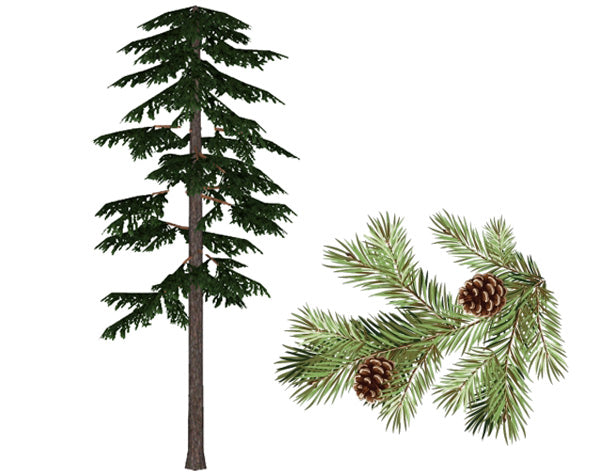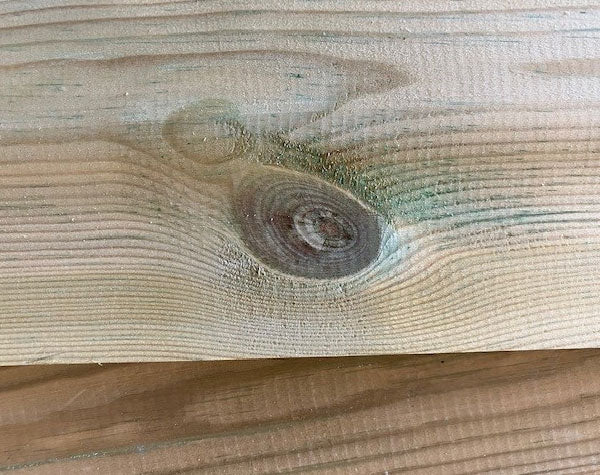Redwood (Pine) or Whitewood (Spruce), which is best?
Answer: Redwood for outdoor furniture; Whitewood for indoor studwork.
So, what is the difference between Pine and Spruce (& Fir)?
Pine and Spruce are both softwoods and are types of coniferous evergreen trees with needles and cones. However, unless you are a tree aficionado, it is sometimes difficult to tell which is which when looking at them as trees (for a more detailed description of wood, see our page about the difference between Hardwood and Softwood?)
There is a difference, of course, especially when it comes to the timber they produce and how it is used. Spruce and Fir are very closely related but Pine is different.

Spruce trees have a distinctive conical shape, with short sharp needles that are easily breakable, and long hanging cones that are flexible with thin scales (image, Norway Spruce).
When sawn for timber, the planks have a creamy white shade and are known as Whitewood.
Fir trees are basically the same as Spruce, it’s hard to tell them apart. Fir is most often grown for Christmas Trees. Like Spruce, their needles grow individually from each branch but the cones, also soft and bendy, grow upwards.

Pine trees are less conically shaped and have clusters of long needles.
The needles of Pine Trees are soft and flexible, with small woody, rigid, hanging cones (image: Scots Pine). These are the most common pine cones used for Christmas decorations.
When sawn, the amber colour of the Scots Pine timber gives it its Redwood name.
EUROPEAN REDWOOD

Redwood - European Redwood that is - is a Scandinavian Pine (Pinus Sylvestris) grown in cooler Boreal Forest climates of Sweden, Norway, and Finland.
It is slow grown for a closer, tighter grain making the timber more dense. Hence it is generally used as joinery timber because it is better quality timber (image: untreated Redwood).
The name 'Redwood' should not be confused with the gigantic Sequoia trees of California (Giant Redwoods), they are different trees.
In the UK, Redwood is commonly Scots Pine and was once seen in large forests all over the country, but it went into decline through deforestation and farming centuries ago. Today, any large areas of Scots Pine are mainly confined to the Caledonian Forest region.
However, they are also widely planted in managed forests throughout Europe. The name Redwood – when used with European, Swedish, Baltic, and Finnish - is purely used to denote its source.
Redwood is one of nature’s stronger timbers and generally resists warping and shakes. It is usually used as a joinery timber to make, for example, skirting boards, staircases, and outdoor furniture. It can easily be sawn, planed and drilled with regular woodworking tools.

Redwood contains natural tannins that help make it durable, perfect for outdoor use, naturally resistant to insects, and readily takes pressure treatment or wood stain. Image: Pressure Treated Redwood, 21mm thick, T&G Shiplap.
Northern European Redwood trees grow up to 25m high with a trunk diameter of around 1m in a sustainably managed forest before being sawn for timber. In sustainable planting, growth can take 50 years or more, depending on how far north the forest is.
A Redwood Pine tree can, if left alone, take over 100 years to reach maturity and this gives it tight growth rings with a high heartwood content. Heartwood is the dense inner part of a tree trunk, it's the hardest timber.
WHITEWOOD
Whitewood is from a Spruce or Fir tree (e.g. a Christmas Tree) and is typically grown very quickly in wetter climates like Scotland.

Norway Spruce (Picea Abies), commonly called Mountain Spruce, is the fastest-growing species. It can grow up to 1.5m (5ft) a year and can reach up to 60m high. Foresters usually harvest Spruce at around 20m-30m high so rotation planting can be every 15-20 years.
Whitewood is typically used in the construction industry - for wooden pallets, box carcasses, indoor wood construction, and fencing timber (when treated). It often has more sap, a straighter grain, and the growth rings are further apart than in slower-grown Redwood. Whitewood is much cheaper than Redwood. Image: Spruce Whitewood.
With the faster growth of Spruce come some deficiencies. The grain of the timber is a lot wider and subsequently less dense. This makes the boards, once machined, much lighter. With that comes an arguably less stable material making it more likely to warp, cup and split, and it is difficult to get a smooth finish. It also doesn’t take pressure treatment or staining quite as well.
So which Timber do we think is best?

After more than 20 years of experience with timber and its capabilities, Flyte so Fancy chooses and only uses, Scandinavian Redwood for all our units - every time.
Sourced from sustainable resources, slow-grown, and Certified, it is the best. The quality, durability, and usability for outdoor products is far superior to Whitewood.
For more details on how we make our timber units see - About Our Garden Storage.
For more information, or hints and tips about pressure-treated timber and its care, please visit our pages about Timber Facts, Figures, Hints & Tips, or perhaps you would like to know more about how Knots in Timber are formed.
© Flyte so Fancy 2022. Author: Phill Weymouth (Director, Flyte so Fancy).To find out who we are visit our About Us page.



